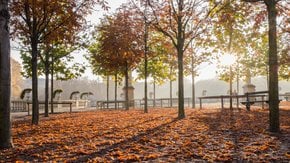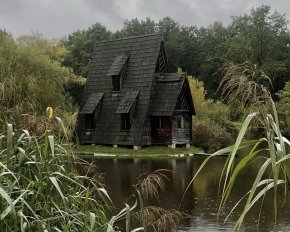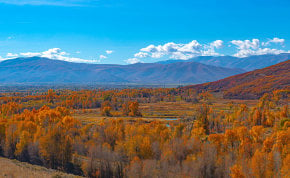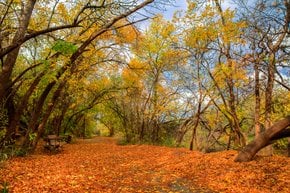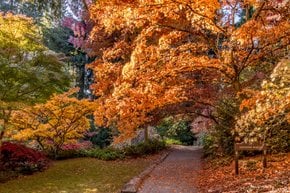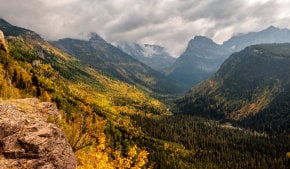Fall Foliage in Kansas 2026
Autumnal grasslands are full of color and life
Best time: late October– early November
After exhausting summer heat, many Kansans look forward to the arrival of mellow fall weather and beautiful fall foliage, transforming the landscapes with golden hues. Kansas is largely a grassland state, and prairies cover approximately 44% of its land. However, Wichita and the Kansas City metro area, especially Olathe and Overland Park, boast many parks. The state also features scenic canyons, rock formations, and sand dunes. Kansas landscapes never look more attractive than in the fall.
When is the best time to see fall foliage in Kansas
Fall colors start to appear in Kansas in late September. The Kansas City area in the northeastern part of the state usually starts to transform earlier. Western and southern parts of Kansas get colorful during the first week of October. Peak fall colors usually fall on the last week of October and the first week of November.
Where to see fall foliage in Kansas
Eisenhower State Park, Osage City
Eisenhower State Park is located 35 miles (56 km) south of Topeka. The park boasts the 6,900-acre (28-sq. km) Melvern Lake as well as 1,345 acres (5.44 sq. km) of prairie and 440 acres (1.8 sq. km) of woodland. The wooded part of the park displays beautiful fall colors in the fall. Besides, it's a great place for wildlife spotting. White-tailed deer, eastern wild turkey, bobwhite quail, and waterfowl birds are abundant in the park.
Baldwin City
Baldwin City, located west of Kansas City, is known for its abundance of maple trees. In the 1920s, the local Maple Leaf Orchard was founded by a local man who had brought maple trees from New England. About 200 colorful trees were also planted throughout the city. Now, Baldwin City holds the annual Maple Leaf Festival during peak fall colors, on the third weekend of October.
Cedar Point Mill
The picturesque historic mill is located in Cedar Point, Kansas. It was constructed for sawing lumber in 1867. At this time, a log dam was also built across the Cottonwood River, In 1868, Cedar Point Mill was converted to grind corn and wheat into flour. In the fall, the mill looks gorgeous due to fall foliage framing the old building.
Bartlett Arboretum
Located 20 miles (32 km) south of Wichita, the Bartlett Arboretum is a historic park in Belle Plaine, Kansas. It is known for the abundance of cypress, oak trees, and Japanese maples, which look especially beautiful in the fall thanks to bright orange, yellow, and red tones. For over 100 years, it has been a favorite natural oasis in the area, called the only mature arboretum between the Mississippi River and the Rocky Mountains.
Little Jerusalem Badlands State Park
Located in the northwest corner of the state, Badlands displays a quintessential Kansas landscape. Even though you won't see many trees here, the area looks gorgeous in the fall. The Badlands area was once part of the sea. Due to centuries of erosion, the picturesque chalk formations in the area acquired interesting forms and shapes. In October, Badlands park showcases stunning golden prairies with a touch of bronze and red.
Marais des Cygnes Wildlife Refuge
Marais des Cygnes National Wildlife Refuge, located along the Marais des Cygnes River in Linn County, boasts 7,500 acres of hardwood forests, a landscape, which is rare in the grassland state. The combination of forests, wetlands, and prairies forms a unique ecosystem for plants and animals.
Scenic Drives
Flint Hills National Scenic Byway runs for 47 miles (75 km) on K-177 between Council Grove and Cassoday. The road, going through Tallgrass Prarie National Preserve, boasts stunning views of grassland and amazing rock formations in the background. The area is transformed with golden and bronze tones during the fall foliage season.
Glacial Hills Scenic Byway, located north of Kansas City, runs for 63 miles (101 km) along the K-7 highway, from Leavenworth to White Cloud. The road boasts stunning vistas of the rolling hills, farmlands, and rock-strewn valleys carved by ancient glaciers.
U.S. Hwy 169 runs from Kansas City to the Chautauqua Hill, sandstone-capped rolling upland, which extends into the Osage Cuestas at the southern Kansas border. The rolling plains dressed in autumnal he Chautauqua Hills is a truly beautiful sight! Stop by Louisburg Cider Mill, located right off of Highway 169, for its annual Louisburg Cider Fest, which takes place in early October!
Gypsum Hills Scenic Byway is nestled in Gypsum Hills, also called The Red Hills, one of the best areas for leaf peeping in Kansas. Located mostly in Clark, Comanche, and Barber counties in southern and central Kansas, within about an hour's drive from Wichita, beautiful red rocks at the Gypsum Hills look especially scenic with golden grass and colorful accents of fall foliage. The area features two scenic overlooks with views of rock formations, buttes, and canyons.







